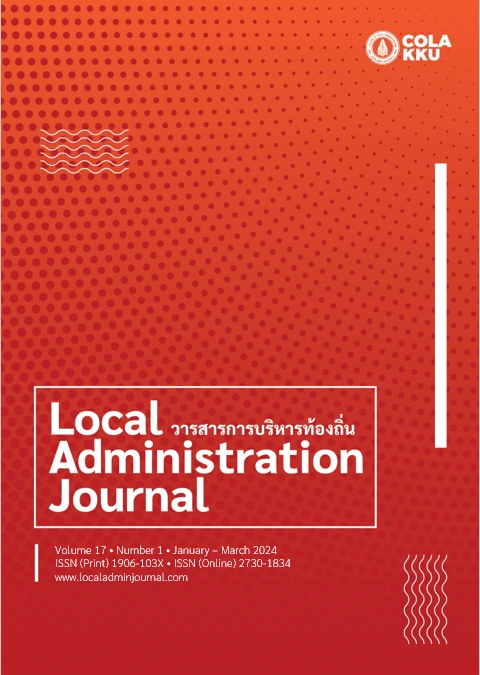The Area-Based Development in Managing Common-Pool Resources of the Underground Water Bank System in Kao Kham Sub-district Administrative Organization Area, Nam Yuen District, Ubon Ratchathani
Keywords:
Common-pool resource management, Underground water bank, Kao KhamAbstract
This study aimed to study the area-based development in managing common-pool resources of the underground water bank system in Kao Kham Subdistrict Administrative Organization area, Nam Yuen District, Ubon Ratchathani. A qualitative research was employed by a case study. The case study was selected from the area of Kao Kham Sub-district Administrative Organization, where was a holistic study. Data were collected through interviews with 20 respondents using a semi-structured interview form and small group meetings for brainstorming. The results were analyzed by a content analysis to find the consistency of the data according to the objective and data triangulation was employed. The study found that the case study began the area-based development in area with repeated flooding and drought problems through the underground water bank project with 2 systems and 5 models since 2015. However, a problem was found related to the confidence of the people sector and local agencies in solving the problem and planning a management system for the underground water bank system in the area. In 2020, digital technology has been employed for management planning and follow-up on water data reports in the underground water bank system, and in 2022, a supportive system for the underground water bank has been developed by a water pumping system contained in a tank and distributing water to groups of farmers who did off-season farming. Based on the area-based development of the management of the underground water bank system, it could analyze the consistency of the results of operations under the common-pool resources management to prevent and solve water-related disasters of the case study in totaling 8 dimensions according to the concept of Elinor Ostrom.
References
Blomquist, W., Schlager, E., Tang, S.Y., & Ostrom, E. (1994). Regularities form the Field and Pos-Sibe Explanations, in (eds.) Ostrom, E., Gardner, R., & Walker, J., Rules, Games and Common-Pool Resources, 301-316. Ann Arbor: University of Michigan Press.
Bunnag, C. (2011). The Concept of Shared Resource Management: Experiences from Abroad and Concepts in Thailand. Nonthaburi: The Reform Office. (in Thai)
Chaichana, J. (2020). Factors Affecting the Effectiveness of the Management of Groundwater Banks. (Master of Public Administration, Public Administration), Rajabhat Mahasarakham University. (in Thai)
Department of Groundwater Resources. (2020). Guidelines for recharging groundwater in Thailand. Bangkok: Bangkok Printing House.
Gavin, M.C., Solomon, J. & Blank, S.G. (2009). Measuring and Monitoring Illegal use of Natural Resources. Conservation Biology, 24(1), 89-100.
Heikkila, T. & Gerlak, A. (2005). The Formation of Large-scale Collaborative Resource Management Institutions: Clarifying the Roles of Stakeholders, Sciences, and Institutions. The Policy Studies Journal, 33(4), 583-612.
Kao Kham Subdistrict Administrative Organization. (2023). Undergroundwater Bank: Guilde to Success from Government to Sustainability of Community. Ubon Ratchathani: Kao Kham Subdistrict Administrative Organization. (in Thai)
Kisman, Z.A. & Yasar, I. (2014). The Key Elements of Local Development. Procedia Economic and Finance, 15, 1689-1696.
Moudjari, M., Marouf, H., Muhamad, H., Chaalal, O., Mequignon, Maherzi, W., & Benzerzour, M. (2021). Using Local Materials to Optimize the Eco-design of a Resilient Urban Environment in Sustainable Urban Project Process. Civil Engineering and Architecture, 9(6), 2084-2097.
Murray, R. & Harris, J. (2010). Water Banking: A Practical Guide to using Artificial Groundwater Recharge. Pretoria: Department of Water Affairs.
Nonthasen, P., Srichaiwong, P. & Nonthasen, K. (2022). Waste Water Management based on the Community Groundwater Bank Model at Ban Khok Kong, Non-Sa-at Subdistrict, Khon Sawan District, Chaiyaphum Province. Interdisciplinary Academic and Research Journal, 2(5), 29-54. (in Thai)
Ostrom, E. (2005). Understanding Institutional Diversity. Princeton, NJ: Princeton University Press.
Ostrom, E. (2010). “Beyond Markets and States: Polycentric Governance of Complex Economic Systems.” American Economic Review, 100, 641-672.
Ostrom, E. 1990. Governing the Commons: The Evolution of Institutions for Collective Action. Cambridge, UK: Cambridge University Press.
Phanthaphech, N. & Chittaladakorn, S. (2021). Sustainable Groundwater Bank Project Management Model of Yasothon Province. Journal of Social Science and Buddhistic Anthropology, 6(3), 92-107. (in Thai)
Pueppke, S.G., Nurtazin, S., & Ou, W. (2020). Water and Land as Shared Resources for Agriculture and Aquaculture: Insights from Asia. Water, 12, 1-24.
Rungsanthawee, T., Kenaphoom, S. & Kosonkittiumporn, S. (2023). Groundwater Bank Innovation in Water Resource Management in the Northeast Region. Interdisciplinary Academic and Research Journal, 3(2), 125-142. (in Thai)
Santiniyom, P. (2021). Model of Groundwater Bank Management for Sustainable Solutions of Drought and Flood in Ubonratchathani Province. (Doctor of Philosophy Program, Department of Public Administration), Mahachulalongkornrajavidyalaya University. (in Thai)
Santiniyom, P., Suyaprom, S. & Suklueng, K. (2022). Model of Groundwater Bank Management for Sustainable Solutions of Drought and Flood in Ubonratchathani Province. Journal of MCU Social Science Review, 11(3), 126-138. (in Thai)
Schlager, E., Blomquist, W., & Tang, S.Y. (1994). Mobile Flows, Storage, and Self-Organized Institutions for Governing Common-Pool Resources. Land Economics, 70(3), 294-317.
Tien, N.H., Phuc, N.T.P., Phu, P.P., Duc, D.M., & Thuc, T.D. (2020). Natural Resources Limitation and the Impact on Sustainable Development of Enterprises. International Journal of Research in Finance and Management, 3(1), 80-84.
Uanlum, P., Thammasarn, P., Prathumchat, A., Kraidej, S. & Prabchandi. K. (2017). Knowledge Management for Water Management for Community Strength and Self-Reliance on Sustainable Water Sources: A Case Study of Ban Kham Klang Underground Water Bank Project, Kao Kham Subdistrict, Nam Yuen District, Ubon Ratchathani Province (Research Report). National Research Council of Thailand. (in Thai)
Yin, R.K. (2014). Case Study Research: Design and Methods. Thousand Oaks, CA: SAGE Publications.
Downloads
Published
How to Cite
Issue
Section
License
Copyright (c) 2024 Local Administration Journal

This work is licensed under a Creative Commons Attribution-NonCommercial-NoDerivatives 4.0 International License.
The copyright of all articles published in the Local Administration Journalis owned by the College of Local Administration, Khon Kaen University.



